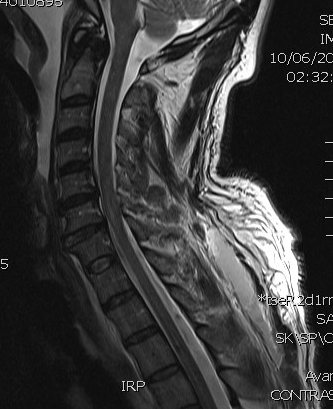 Stenosis in the neck, also called the cervical spine, affects the upper part of the body including the arms and hands. Stenosis is the narrowing of the bony canal that protects the spinal cord and its branching nerves to the point where it injures the spinal cord or nerves.
Stenosis in the neck, also called the cervical spine, affects the upper part of the body including the arms and hands. Stenosis is the narrowing of the bony canal that protects the spinal cord and its branching nerves to the point where it injures the spinal cord or nerves.
This may be caused by a number of conditions including bone spurs or rupture of the spinal discs, the spongy pads of tissue that keep the vertebrae from grinding against each other when you bend your back.
What to look for
Most cases of stenosis in the neck, or cervical stenosis, develop in patients over age 50 because of wear and tear on the spine. Some patients are born with condition and others develop it after a spine injury.
Cervical stenosis most often causes stiffness or pain in the neck, which may increase over time. Other symptoms include:
- Stiffness, pain or numbness in the shoulder, arm, hand or leg
- Burning or tingling sensation, or the feeling of pins and needles, in the shoulder, arm or hand or leg
- Balance and coordination problems when walking
In severe cases, bladder and bowel problems
Tests
- X-ray
- CT scans
- MRI
You may be referred to have a special test looking at the nerve function called a nerve conduction study, usually performed by a Neurologist.
Treatment
If several months of treatment have not improved the symptoms, and if the stenosis is severe, surgery to widen the spinal canal may be necessary. Because bone continues to deteriorate, additional treatment may be needed several years after even successful surgery. Operations used to treat stenosis include:
Anterior Cervical Discectomy and Fusion — A small incision in the front of the neck is used to access the upper spine. The ruptured or herniated disc is removed and replaced with a small bone plug, which eventually grows to connect the two adjacent vertebrae.
Cervical Corpectomy — Part of the vertebra and discs are removed and replaced with a bone graft or a metal plate and screws to support the spine.
Decompressive Laminectomy — The roof of the vertebrae, called the lamina, is surgically removed. The procedure also may include removing part of the disc or fusing the vertebrae (spinal fusion).
- Laminotomy — Only a small portion of the lamina is removed.
- Cervical Disc Replacement —Instead of fusing the affected area, the natural disc material is replaced with a metal and plastic prosthesis that maintains or restores the motion segment.

